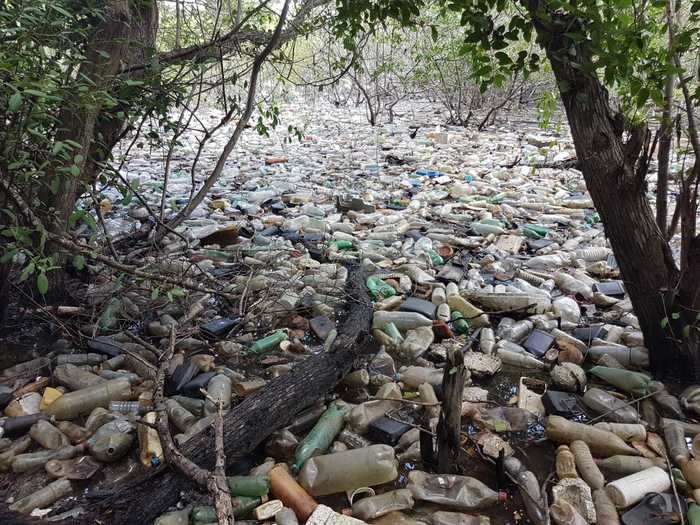
Almost half of all the plastic ever manufactured has been made in the last two decades, National Geographic reported. But despite this massive increase in manufacturing, only 20% of plastic is recycled.
Close to 1 million plastic bottles are sold around the world each minute. In the photo above, hundreds of plastic bottles were found in Honduras.

Garbage is collected in the middle of the U-shaped contraption, and the device's holes allow water to be released.
The holes also let marine life escape, Birnbaum said, so turtles and other animals do not get trapped.
Based on rough estimates, Birnbaum said the contraption could likely collect 20 tons of trash in one round. He said half of the trash collected is plastic, and most of the plastic comes from bottles.

One Holy Turtle expedition would collect a few tons in a matter of hours, gathering very little plastic relative to the total amount of trash in the ocean.
"It's not about the collection. No one can collect enough," Birnbaum said. "The amount of trash that is being pumped into the ocean regularly, every minute, is greater than what we can ever collect."
Instead, SodaStream aims to educate people about the magnitude of this issue.
"Humanity is fighting for its existence," he said. "We could be the dinosaurs of this generation."

He added that people with disabilities or those who just prefer to use straws should rely on paper or stainless steel straws instead.
While plastic straws are still found nearly everywhere in the United States, an increasing number of companies are taking steps to get rid of them.
Starbucks, for example, is phasing out plastic straws and will replace them with paper ones in all stores by 2020. Goldman Sachs has joined the movement as well, and all of its US offices will eliminate plastic straws by the end of this year.
The straw ban is also gaining some traction among legislators, with California deciding to ban sit-down restaurants from serving plastic straws to customers starting next year.

Plastic can have a fatal effect on marine life, but very little is known about its impact on human health.
Studies have shown that people commonly ingest plastic through fish and other foods. After some major brands of bottled water were found to contain plastic particles, the World Health Organization announced this year that it will investigate whether eating and drinking plastic particles can harm humans.
Birnbaum said he is worried it may take a long time for the WHO to investigate, adding that scientists do not have a control group to compare results to.

Due to currents and rain patterns, miles-long garbage patches sometimes accumulate near the island. The Holy Turtle was designed to tackle trash floating in shallow waters like those surrounding Honduras, not deep ocean waters.

The Ocean Cleanup spent about five years working on a solution to clean plastic from oceans, finally unveiling its 2,000-foot-long plastic cleaning array in September.
Founder Boyan Slat wants to clean plastic from the Great Pacific Garbage Patch, a vortex of trash in the North Pacific Ocean that is more than three times the size of Spain. The Ocean Cleanup says it can remove half of the patch's plastic in five years if it deploys 60 of its plastic-collecting arrays.
Some experts have voiced concern about The Ocean Cleanup, saying it will be ineffective and cause marine life to get trapped in the debris. Slat's team later defended the safety and design of the project.
Birnbaum said SodaStream's device will not harm marine life, noting that the two devices were made to collect trash from different water depths.

It cost Birnbaum's team more than $1 million to build the Holy Turtle, travel to Honduras, and complete the cleanup.

Roatán does not have proper treatment facilities, Birnbaum said, so all the plastic collected needs to be brought to the mainland.

Birnbaum said he wants this project to serve as an educational tool for people around the world.
 Saudi Arabia wants China to help fund its struggling $500 billion Neom megaproject. Investors may not be too excited.
Saudi Arabia wants China to help fund its struggling $500 billion Neom megaproject. Investors may not be too excited. I spent $2,000 for 7 nights in a 179-square-foot room on one of the world's largest cruise ships. Take a look inside my cabin.
I spent $2,000 for 7 nights in a 179-square-foot room on one of the world's largest cruise ships. Take a look inside my cabin. One of the world's only 5-star airlines seems to be considering asking business-class passengers to bring their own cutlery
One of the world's only 5-star airlines seems to be considering asking business-class passengers to bring their own cutlery Experts warn of rising temperatures in Bengaluru as Phase 2 of Lok Sabha elections draws near
Experts warn of rising temperatures in Bengaluru as Phase 2 of Lok Sabha elections draws near
 Axis Bank posts net profit of ₹7,129 cr in March quarter
Axis Bank posts net profit of ₹7,129 cr in March quarter
 7 Best tourist places to visit in Rishikesh in 2024
7 Best tourist places to visit in Rishikesh in 2024

Copyright © 2024. Times Internet Limited. All rights reserved.For reprint rights. Times Syndication Service.